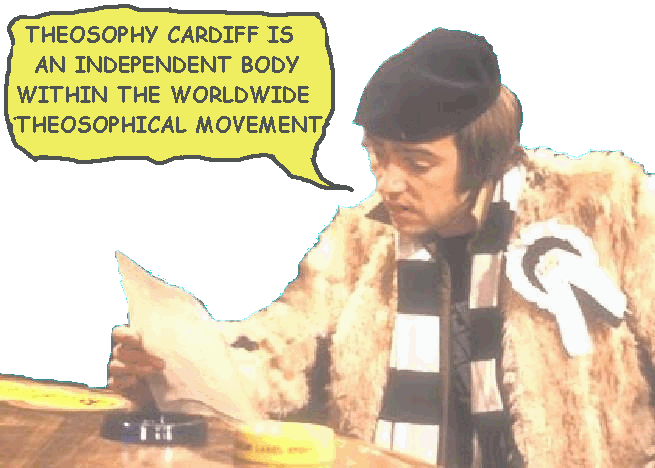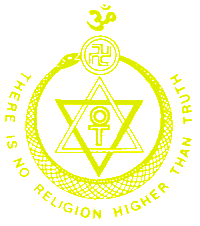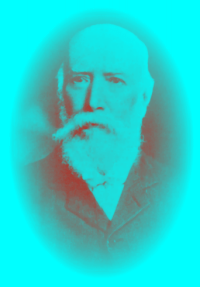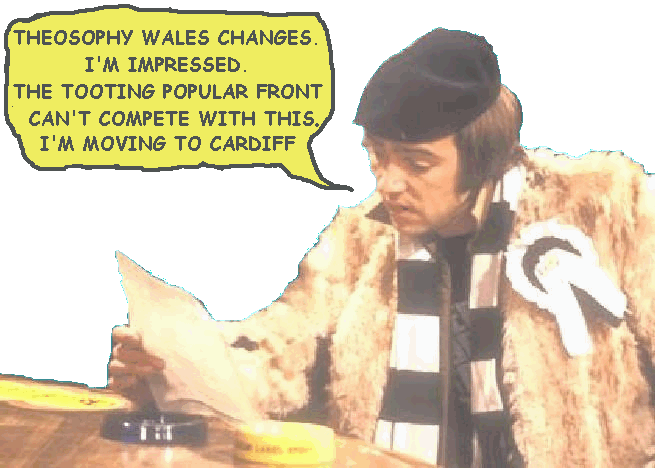VANGUARD
Phase
1 Standard Vanguard introduced July 1947
The Standard Vanguard was produced
by
the Standard Motor Company
in
The Standard Vanguard has very little (in fact
nothing)
to do with Theosophy but we have found that
Theosophists and new enquirers do like pictures
of classic cars and we get a lot of positive
feedback.
You can find Theosophy Wales groups
in
Bangor, Cardiff, Conwy
& Swansea
Theosophy Wales has no controlling
body
and is made up of
independent groups
________________________
Theosophy Wales Vanguard
isnt just about
classic cars, we are pleased to present here
an in depth manual of Theosophical ideas
and concepts by Alfred Percy Sinnett who
was a major contributor to the development
of modern Theosophy
in the early years
of the Theosophical movement
Esoteric
Buddhism
By
Alfred
Percy Sinnett
Kāma Loca
Chapter 6
THE statements already made
in reference to the destiny of the higher human principles at death will pave
the way for a comprehension of the circumstances in which the inferior remnant
of these principles finds itself, after the real Ego has passed either into the
Devachanic state, or that unconscious intervening period of preparation
therefore, which corresponds to physical gestation. The sphere in which such
remnants remain for a time is known to occult science as Kāma loca, the region of desire, not the region in which desire
is developed to any abnormal degree of intensity, as compared with desire as it
attaches to earth life, but the sphere in which that sensation of desire, which
is a part of the earth life, is capable of surviving.
It will be obvious, from what
has been said about Devachan, that a large part of the recollections which
accumulate round the human Ego during life are incompatible in their nature
with the pure subjective existence to which the real, durable, spiritual Ego
passes; but they are not necessarily on that account extinguished or
annihilated out of existence. They inhere in certain molecules of those finer
(but not finest) principles, which escape from the body at death; and just as
dissolution separates what is loosely called the soul from the body, so also it
provokes a further separation between the constituent elements of the soul. So
much of the fifth principle, or human soul, which is in its nature assimilable with, or has gravitated upward towards, the
sixth principle, the spiritual soul, passes with the germ of that divine soul
into the superior region, or state of Devachan, in which it separates itself
almost completely from the attractions of the earth; quite completely, as far
as its own spiritual course is concerned, though it still has certain
affinities with the spiritual aspirations emanating from the earth, and may
sometimes draw these towards itself. But the animal soul, or fourth, principle
(the element of will and desire, as associated with objective existence), has
no upward attraction, and no more passes away from the earth than the particles
of the body consigned to the grave. It is not in the grave, however, that this
fourth principle can be put away. It is not spiritual in its nature or
affinities, but it is not physical in its nature. In its affinities it is
physical, and hence the result. It remains within the actual physical local
attraction of the earth - in the earths atmosphere - or, since it is not the
gases of the atmosphere that are specially to be considered in connection with
the problem in hand, let us say, in Kāma loca.
And with the fourth principle
a large part (as regards most of mankind unfortunately, though a part very
variable in its relative magnitude) inevitably remains. There are plenty of
attributes which the ordinary composite human being exhibits, many ardent
feelings, desires, and acts, floods of recollections, which, even if not
concerned with a life as ardent perhaps as those which have to do with the
higher aspirations, are nevertheless essentially belonging to the physical
life, which take time to die. They remain behind in association with the fourth
principle, which is altogether of the earthly perishable nature, and disperse
or fade out, or are absorbed into the respective universal principles to which
they belong just as the body is absorbed into the earth, in progress of time,
and rapidly or slowly, in proportion to the tenacity of their substance. And
where meanwhile is the consciousness of the individual who has died or dissolved?
Assuredly in Devachan; but a difficulty presents itself to the mind untrained
in occult science, from the fact that a semblance of consciousness inheres in
the astral portion - the fourth principle, with a portion of the fifth - which
remains behind in Kāma loca. The individual
consciousness, it is argued, cannot be in two places at once. But first of all,
to a certain extent, it can. As may be perceived presently, it is a mistake to
speak of consciousness, as we understand the feeling of life, attaching to the
astral shell or remnant; but nevertheless a certain spurious manifestation of
consciousness may be reawakened in the shell, without having any connection
with the real consciousness all the while growing in strength and vitality in
the spiritual sphere. There is no power on the part of the shell of taking in
and assimilating new ideas and initiating courses of action on the basis of
those new ideas. But there is in the shell a survival of volitional impulses
imparted to it during life. The fourth principle is the instrument of volition,
though not volition itself, and impulses imparted to it during life by the
higher principles may run their course and produce results almost
indistinguishable for careless observers from those which would ensue were the
four higher principles really all united, as in life.
The fourth principle, is the
vehicle during life of that essentially mortal consciousness which cannot suit
itself to conditions of permanent existence; but the consciousness even of the
lower principles during life is a very different thing from the
vaporous, fleeting and uncertain consciousness which continues to inhere in
them when that which really is the life, the over-shadowing of them, or
their vitalization by the infusion of the spirit, has ceased, as far as they
are concerned. Language cannot render all the facets of a many-sided idea
intelligible at once, any more than a plain drawing can show all sides of a
solid object. And at the first glance different drawings of the same object
from different points of view may seem so unlike as to be unrecognizable as the
same, but none the less, by the time they are put together in the mind, will
their diversities be seen to harmonize. So with these subtle attributes of the
invisible principles of man - no treatise can do more than discuss their
different aspects separately. The various views suggested must mingle in the
readers mind before the complete conception corresponds to the realities of
Nature.
In life the fourth principle
is the seat of will and desire, but it is not will itself. It must be alive, in
union with the overshadowing spirit, or one life, to be thus the agent of
that very elevated function of life - will, in its sublime potency. As already
mentioned, the Sanscrit names of the higher
principles connote the idea that they are vehicles of the one life. Not that
the one life is a separable molecular principle itself; it is the union of all
- the influence of the spirit; but in truth the idea is too subtle for
language, perhaps for intellect itself. Its manifestation in the present case,
however, is apparent enough. Whatever the willing fourth principle may be when
alive, it is no longer capable of active will when dead. But then, under
certain abnormal conditions, it may partially recover life for a time; and this
fact it is which explains many, though by no means all, of the phenomena of
spiritualistic mediumship. The elementary, be it
remembered - as the astral shell has generally been called in former occult
writings - is liable to be galvanized for a time in the mediumistic current
into a state of consciousness and life, which may be suggested by the first
condition of a person who, carried into a strange room in a state of
insensibility during illness, wakes up feeble, confused in mind; gazing about
with a blank feeling of bewilderment, taking in impressions, hearing words
addressed to him, and answering vaguely. Such a state of consciousness is
unassociated with the notions of past or future. It is an automatic
consciousness, derived from the medium. A medium, be it remembered, is a person
whose principles are loosely united and susceptible of being borrowed by other
beings, or by floating principles, having an attraction for some of them or
some part of them. Now what happens in the case of a shell drawn into the neighbourhood of a person so constituted? Suppose the
person from whom the shell has been cast, died with some strong unsatisfied
desire, not necessarily of an unholy sort, but connected entirely with the
earth life, a desire, for example, to communicate some fact to a still living
person. Certainly the shell does not go about in Kāma loca
with a persistent intelligent conscious purpose of communicating that fact;
but, amongst others, the volitional impulse to do this has been infused into
the fourth principle, and while the molecules of that principle remain in
association, (and that may be for many years,) they only need a partial
galvanization into life again, to become operative in the direction of the
original impulse. Such a shell comes into contact with a medium (not so
dissimilar in nature from the person who had died as to render a rapport
impossible), and something from the fifth principle of the medium associates
itself with the wandering fourth principle, and sets the original impulse to
work. So much consciousness and so much intelligence as may be required to
guide the fourth principle in the use of the immediate means of communication
at hand - a slate and pencil, or a table to rap upon - is borrowed from the medium,
and then the message given may be the message which the dead person originally
ordered his fourth principle to give, so to speak, but which the shell has
never till then had an opportunity of giving. It may be argued that the
production of writing on a closed slate, or of raps on a table without the use
of a knuckle or a stick, is itself a feat of a marvellous nature, bespeaking a
knowledge on the part of the communicating intelligence of powers in Nature we
in physical life know nothing about. But the shell is itself in the astral
world; in the realm of such powers. A phenomenal manifestation is its natural
mode of dealing. It is no more conscious of producing a wonderful result by the
use of new powers acquired in a higher sphere of existence, than we are
conscious of the forces by which in life the volitional impulse is communicable
to nerves and muscles.
But, it may be objected, the
communicating intelligence at a spiritual séance will constantly
perform remarkable feats for no other than their own sake, to exhibit the power
over natural forces which it possesses. The reader will please remember,
however, that occult science is very far from saying that all the phenomena of
spiritualism are traceable to one class of agents. Hitherto in this treatise
little has been said of the elementals, those semi-intelligent creatures of
the astral light, who belong to a wholly different kingdom of Nature from
ourselves. Nor is it possible at present to enlarge upon their attributes, for
the simple and obvious reason that knowledge concerning the elementals,
detailed knowledge on that subject, and in regard to the way they work, is
scrupulously withheld by the adepts of occultism. To possess such knowledge is
to wield power, and the whole motive of the great secrecy in which occult
science is shrouded turns upon the danger of conferring powers upon people who
have not, first of all, by undergoing the training of initiates, given moral
guarantees of their trustworthiness. It is by command over the elementals that
some of the greatest physical feats of adeptship are
accomplished; and it is by the spontaneous playful acts of the elementals that
the greatest physical phenomena of the séance room are brought about. So
also with almost all Indian Fakirs and Yogis of the lower class who have power
of producing phenomenal results. By some means, by a scrap of inherited occult
teaching, most likely, they have come into possession of a morsel of occult
science. They may not necessarily understand the action of the forces they
employ, any more than an Indian servant in a telegraph office, taught how to
mix the ingredients of the liquid used in a galvanic battery, understands the
theory of electric science. He can perform the one trick he has been taught;
and so with the inferior Yogi. He has got influence over certain elementals,
and can work certain wonders.
Returning to a consideration
of the ex-human shells in Kāma loca, it may be argued
that their behaviour in spiritual séances is
not covered by the theory that they have had some message to deliver from their
late master, and have availed themselves of the mediumship
present, to deliver it. Apart altogether from phenomena that may be put aside
as elemental pranks, we sometimes encounter a continuity of intelligence on the
part of the elementary or shell that bespeaks much more than the survival of
impulses from the former life. Quite so; but with portions of the mediums
fifth principle conveyed into it, the fourth principle is once more an
instrument in the hands of a master. With a medium entranced so that the
energies of the fifth principle are conveyed into the wandering shell to a very
large extent, the result is that there is a very tolerable revival of
consciousness in the shell for the time being, as regards the given moment. But
what is the nature of such consciousness, after all? Nothing more, really, than
a reflected light. Memory is one thing, and perceptive faculties quite another.
A madman may remember very clearly some portions of his past life; yet he is unable
to perceive anything in its true light, for the higher portion of his Manas,
fifth, and Buddhi, sixth, principles, are paralysed
in him and have left him. Could an animal - a dog, for instance - explain
himself, he could prove that his memory, in direct relation to his canine
personality, is as fresh as his masters; nevertheless, his memory and instinct
cannot be called perceptive faculties.
Once that a shell is in the
aura of a medium, he will perceive, clearly enough, whatever he can perceive
through the borrowed principles of the medium, and through organs in magnetic
sympathy therewith; but this will not carry him beyond the range of the
perceptive faculties of the medium, or of some one else present in the circle.
Hence the often rational and sometimes highly intelligent answers he may give,
and hence, also, his invariably complete oblivion of all things unknown to that
medium or circle, or not found in the lower recollections of his late
personality, galvanized afresh by the influences under which he is placed. The
shell of a highly intelligent, learned, but utterly unspiritual man, who died a
natural death, will last longer than those of weaker temperament, and (the
shadow of his own memory helping) he may deliver, through trance-speakers,
orations of no contemptible kind. But these will never be found to relate to
anything beyond the subjects he thought much and earnestly of during life, nor
will any word ever fall from him indicating a real advance of knowledge.
It will easily be seen that a
shell, drawn into the mediumistic current, and getting into rapport with
the mediums fifth principle, is not by any means sure to be animated with a
consciousness (even for what such consciousness are worth) identical with the
personality of the dead person from whose higher principles it was shed. It is
just as likely to reflect some quite different personality, caught from the
suggestions of the mediums mind. In this personality it will perhaps remain
and answer for a time; then some new current of thought thrown into the minds
of the people present, will find its echo in the fleeting impressions of the
elementary, and his sense of identity will begin to waver; for a little while
it flickers over two or three conjectures, and ends by going out altogether for
a time. The shell is once more sleeping in the astral light, and may be
unconsciously wafted in a few moments to the other ends of the earth.
Besides the ordinary
elementary or shell of the kind just described, Kāma loca
is the abode of another class of astral entities, which must be taken into
account if we desire to comprehend the various conditions under which human
creatures may pass from this life to others. So far we have been examining the
normal course of events, when people die in a natural manner. But an abnormal
death will lead to abnormal consequences. Thus, in the case of persons
committing suicide, and in that of persons killed by sudden accident, results
ensue which differ widely from those following natural deaths. A thoughtful
consideration of such cases must show, indeed, that in a world governed by rule
and law, by affinities working out their regular effects in that deliberate way
which Nature favours, the case of a person dying a
sudden death at a time when all his principles are firmly united, and ready to
hold together for twenty, forty, or sixty years, whatever the natural remainder
of his life would be, must surely be something different from that of a person
who, by natural processes of decay, finds himself, when the vital machine
stops, readily separable into his various principles, each prepared to travel
their separate ways. Nature, always fertile in analogies, at once illustrates
the idea by showing us a ripe and an unripe fruit. From out of the first the
inner stone will come away as cleanly and easily as a hand from a glove, while
from the unripe fruit the stone can only be torn with difficulty, half the pulp
clinging to its surface. Now, in the case of the sudden accidental death or of
the suicide, the stone has to be torn from the unripe fruit. There is no
question here about the moral blame which may attach to the act of suicide.
Probably, in the majority of cases, such moral blame does attach to it, but
that is a question of Karma which will follow the person concerned into the
next re-birth, like any other Karma, and has nothing to do with the immediate
difficulty such person may find in getting himself thoroughly and wholesomely
dead. This difficulty is manifestly just the same, whether a person kills
himself, or is killed in the heroic discharge of duty, or dies the victim of an
accident over which he has no control whatsoever.
As an ordinary rule, when a
person dies, the long account of Karma naturally closes itself - that is to
say, the complicated set of affinities which have been set up during life in
the first durable principle, the fifth, is no longer susceptible of extension.
The balance-sheet, so to speak, is made out afterwards, when the time comes for
the next objective birth; or, in other words, the affinities long dormant in
Devachan, by reason of the absence there of any scope for their action, assert
themselves as soon as they come in contact once more with physical existence.
But the fifth principle, in which these affinities are grown, cannot be
separated, in the case of the person dying prematurely, from the earthly
principle - the fourth. The elementary, therefore, which finds itself in Kāma loca, on its violent expulsion from the body is not a mere
shell - it is the person himself, who was lately alive, minus nothing
but the body. In the true sense of the word, he is not dead at all.
Certainly elementaries
of this kind may communicate very effectually at spiritual séances at
their own heavy cost; for they are unfortunately able, by reason of the
completeness of their astral constitution, to go on generating Karma, to
assuage their thirst for life at the unwholesome spring of mediumship.
If they were of a very material sensual type in life, the enjoyments they will
seek will be of a kind the indulgence of which in their disembodied state may
readily be conceived even more prejudicial to their Karma than similar
indulgences would have been in life. In such cases facilis
est descensus. Cut off
in the full flush of earthly passions which bind them to familiar scenes, they
are enticed by the opportunity which mediums afford for the gratification of
these vicariously. They become the incubi and succubi
of mediaeval writing, demons of thirst and gluttony, provoking their victims to
crime. A brief essay on this subject, which I wrote last year, and from which I
have reproduced some of the sentences just given, appeared in the Theosophist,
with a note, the authenticity of which I have reason to trust, and the tenor of
which was as follows: -
The variety of states after
death is greater if possible than the variety of human lives upon this earth.
The victims of accident do not generally become earth walkers, only those
falling into the current of attraction who die full of some engrossing earthly
passion, the selfish, who have never given a thought to the welfare of
others. Overtaken by death in the consummation, whether real or imaginary, of
some master passion of their lives, the desire remaining unsatisfied, even
after a full realization, and they still craving for more, such personalities
can never pass beyond the earth attraction to wait for the hour of deliverance
in happy ignorance and full oblivion. Among the suicides, those to whom the
above statement about provoking their victims to crime, &c., applies, are
that class who commit the act, in consequence of a crime, to escape the penalty
of human law or their own remorse. Natural law cannot be broken with impunity;
the inexorable causal relation between action and result has its full sway only
in the world of effects, the Kāma loca, and every
case is met there by an adequate punishment, and in a thousand ways, that would
require volumes even to describe them superficially.
Those who wait for the hour
of deliverance in happy ignorance and full oblivion are of course such victims
of accident as have already on earth engendered pure and elevated affinities,
and after death are as much beyond the reach of temptation in the shape of
mediumistic currents as they would have been inaccessible in life to common
incitements to crime.
Entities of another kind
occasionally to be found in Kāma loca have yet to be
considered. We have followed the higher principles of persons recently dead,
observing the separation of the astral dross from the spirituality durable
portion; that spirituality durable portion being either holy or Satanic in its
nature, and provided for in Devachan or Avitchi
accordingly. We have examined the nature of the elementary shell cast off and
preserving for a time a deceptive resemblance to a true entity; we have paid
attention also to the exceptional cases of real four-principled beings in Kāma loca who are the victims of accident or suicide. But what
happens to a personality which has absolutely no atom of spirituality, no trace
of spiritual affinity in its fifth principle, either of the good or bad sort?
Clearly in such a case there is nothing for the sixth principle to attract to
itself. Or, in other words, such a personality has already lost its sixth
principle by the time death comes. But Kāma loca is
no more a sphere of existence for such a personality than the subjective world;
Kāma loca may be permanently inhabited by astral
beings, by elementals, but can only be an antechamber to some other state for
human beings. In the case imagined, the surviving personality is promptly drawn
into the current of its future destinies, and these have nothing to do with
this earths atmosphere or with Devachan, but with that eighth sphere of
which occasional mention will be found in older occult writings. It will have
been unintelligible to ordinary readers hitherto why it was called the eighth
sphere, but since the explanation, now given out for the first time, of the
sevenfold constitution of our planetary system, the meaning will be clear
enough. The spheres of the cyclic process of evolution are seven in number, but
there is an eighth in connection with our earth, our earth being, it will be
remembered, the turning-point in the cyclic chain, and this eighth sphere is
out of circuit, a cul de sac, and the bourne from which it may be truly said no traveller returns.
It will readily be guessed
that the only sphere connected with our planetary chain, which is lower than
our own in the scale, having spirit at the top and matter at the bottom, must
itself be no less visible to the eye and to optical instruments than the earth
itself, and as the duties which this sphere has to perform in our planetary
system are immediately associated with this earth, there is not much mystery
left now in the riddle of the eighth sphere, nor as to the place in the sky
where it may be sought. The conditions of existence there, however, are topics
on which the adepts are very reserved in their communications to uninitiated
pupils, and concerning these I have for the present no further information to
give.
One statement though is
definitely made-viz., that such a total degradation
of a personality as may suffice to draw it, after death, into the attraction of
the eighth sphere, is of very rare occurrence. From the vast majority of lives
there is something which the higher principles may draw to themselves,
something to redeem the page of existence just passed from total destruction,
and here it must be remembered that the recollections of life in Devachan, very
vivid as they are, as far as they go, touch only those episodes in life that
are productive of the elevated sort of happiness of which alone Devachan is
qualified to take cognizance, whereas the life from which, for the time being,
the cream is thus skimmed, may come to be remembered eventually in all its
details quite fully. That complete remembrance is only achieved by the
individual at the threshold of a far more exalted spiritual state than that
which we are now concerned with; one which is attained far later on in the
progress of vast cycles of evolution. Each one of the long series of lives that
will have been passed through will then be, as it were, a page in a book to
which the possessor can turn back at pleasure, even though many such pages will
then seem to him most likely, very dull reading, and will not be frequently
referred to. It is this revival eventually of recollection concerning all the
long-forgotten personalities that is really meant by the doctrine of the
Resurrection. But we have no time at present to stop and unravel the enigmas of
symbolism as bearing upon the teachings at present under conveyance to the
reader. It may be worth while to do this as a separate undertaking at a later
period; but meanwhile, to revert to the narrative of how the facts stand, it
may be explained that in the whole book of pages, when at last the
resurrection has been accomplished, there will be no entirely infamous pages;
for even if any given spiritual individuality has occasionally, during its
passage through this world, been linked with personalities so deplorably and
desperately degraded that they have passed completely into the attraction of
the lower vortex, that spiritual individuality in such cases will have
retained, in its own affinities, no trace or taint of them. Those pages will,
as it were, have been cleanly torn out from the book. And, as at the end of the
struggle, after crossing Kāma loca, the spiritual
individuality will have passed into the unconscious gestation state from which,
skipping the Devachan state, it will be directly (though not immediately in
time) reborn into its next life of objective activity, all the
self-consciousness connected with that existence will have passed into the
lower world, there eventually to perish everlastingly; an expression of
which, as of so many more, modern theology has proved a faithless custodian,
making pure nonsense out of psycho-scientific facts.
ANNOTATIONS
There is no part of the
present volume which I now regard as in so much urgent need of amplification as
the two chapters which have just been passed. The Kāma loca
stage of existence, and that higher region or state of Devachan, to which it is
but the antechamber, were, designedly I take it, left by our teachers in the
first instance in partial obscurity, in order that the whole scheme of
evolution might be the better understood. The spiritual state which immediately
follows our present physical life, is a department of Nature, the study of
which is almost unhealthily attractive for every one who once realizes that
some contact with it - some processes of experiment with its conditions - are
possible even during this life. Already we can to a certain extent discern the
phenomena of that state of existence into which a human creature passes at the
death of the body. The experience of spiritualism has supplied us with facts
concerning it in very great abundance. These facts are but too highly
suggestive of theories and inferences which seem to reach the ultimate limits
of speculation, and nothing but the bracing mental discipline of esoteric study
in its broadest aspect will protect any mind addressed to the consideration of
these facts from conclusions which that study shows to be necessarily
erroneous. For this reason, theosophical inquirers have nothing to regret as
far as their own progress in spiritual science is at stake, in the
circumstances which have hitherto induced them to be rather neglectful of the
problems that have to do with the state of existence next following our own. It
is impossible to exaggerate the intellectual advantages to be derived from
studying the broad design of Nature throughout those vast realms of the future
which only the perfect clairvoyance of the adepts can penetrate, before going
into details regarding that spiritual foreground, which is partially accessible
to less powerful vision, but liable, on a first acquaintance, to be mistaken
for the whole expanse of the future.
The earlier processes,
however, through which the soul passes at death, may be described at this date
somewhat more fully than they are defined in the foregoing chapter. The nature
of the struggle that takes place in Kāma loca between
the upper and lower duads may now, I believe, be
apprehended more clearly than at first. That struggle appears to be a very
protracted and variegated process, and to constitute,- not as some of us may
have conjectured at first, an automatic or unconscious assertion of affinities
or forces quite ready to determine the future of the spiritual monad at the
period of death, - but a phase of existence which may be, and in the vast
majority of cases is more than likely to be, continued over a considerable
series of years. And during this phase of existence it is quite possible for
departed human entities to manifest themselves to still living persons through
the agency of spiritual mediumship, in a way which
may go far towards accounting for, if it does not altogether vindicate, the
impressions that spiritualists derive from such communications.
But we must not conclude too
hastily that the human soul going through the struggle or evolution of Kāma loca is in all respects what the first glance at the
position, as thus defined, may seem to suggest. First of all, we must beware of
too grossly materializing our conception of the struggle, by thinking of it as
a mechanical separation of principles. There is a mechanical separation
involved in the discard of lower principles when the consciousness of the Ego
is firmly seated in the higher. Thus at death the body is mechanically discarded
by the soul, which (in union, perhaps, with intermediate principles), may
actually be seen by some clairvoyants of a high order to quit the tenement it
needs no longer. And a very similar process may ultimately take place in Kāma loca itself, in regard to the matter of the astral
principles. But postponing this consideration for a few moments, it is
important to avoid supposing that the struggle of Kāma loca
does itself constitute this ultimate division of principles, or second death
upon the astral plane.
The struggle of Kāma loca is in fact the life of the entity in that phase of
existence. As quite correctly stated in the text of the foregoing chapter, the
evolution taking place during that phase of existence is not concerned with the
responsible choice between good and evil which goes on during physical life.
Kāma loca is a portion of the great world of effects,
- not a sphere in which causes are generated (except under peculiar
circumstances). The Kāma loca entity, therefore, is
not truly master of his own acts; he is rather the sport of his own already
established affinities. But these are all the while asserting themselves, or
exhausting themselves, by degrees, and the Kāma loca
entity has an existence of vivid consciousness of one sort or another the whole
time. Now a moments reflection will show that those affinities, which are
gathering strength and asserting themselves, have to do with the spiritual
aspirations of the life last experienced, while those which are exhausting
themselves have to do with its material tastes, emotions, and
proclivities. The Kāma loca entity, be it remembered,
is on his way to Devachan, or, in other words, is growing into that state which
is the Devachanic state, and the process of growth is accomplished by action
and reaction, by ebb and flow, like almost every other in Nature, - by a
species of oscillation between the conflicting attractions of matter and
spirit. Thus the Ego advances towards Heaven, so to speak, or recedes towards
earth, during his Kāma loca existence, and it is just
this tendency to oscillate between the two poles of thought or condition, that
brings him back occasionally within the sphere of the life he has just quitted.
It is not by any means at
once that his ardent sympathies with that life are dissipated. His sympathies
with the higher aspects of that life, be it remembered, are not even on their
way to dissipation. For instance, in what is here referred to as earthly
affinity, we need not include the exercise of affection, which is a function of
Devachanic existence in a pre-eminent degree. But perhaps even in regard to his
affections there may be earthly and spiritual aspects of these, and the
contemplation of them, with the circumstances and surroundings of the
earth-life, may often have to do with the recession towards earth-life of the
Kāma loca entity referred to above.
Of course it will be apparent
at once that the intercourse which the practice of spiritualism sets up between
the Kāma loca entities as here in view, and the friends
they have left on earth, must go on during those periods of the souls
existence in which earth memories engage its attention; and there are two
considerations of a very important nature which arise out of this reflection.
1st. While its
attention is thus directed, it is turned away from the spiritual progress on
which it is engaged during its oscillations in the other direction. It may
fairly well remember, and in conversation refer to, the spiritual aspirations
of the life on earth, but its new spiritual experiences appear to be of an
order that cannot be translated back into terms of the ordinary physical
intellect, and, besides that, to be not within the command of the faculties
which are in operation in the soul during its occupation with old-earth
memories. The position might be roughly symbolized, but only to a very
imperfect extent, by the case of a poor emigrant, whom we may imagine
prospering in his new country, getting educated there, concerning himself with
its public affairs and discoveries, philanthropy, and so on. He may keep up an
interchange of letters with his relations at home, but he will find it
difficult to keep them au courant with all that has come to be occupying
his thoughts. The illustration will only fully apply to our present purpose,
however, if we think of the emigrant as subject to a psychological law which
draws a veil over his understanding when he sits down to write to his former
friends, and restores him during that time to his former mental condition. He
would then be less and less able to write about the old topics as time went on,
for they would not only be below the level of those to the consideration of
which his real mental activities had risen, but would to a great extent have
faded from his memory. His letters would be a source of surprise to their
recipients, who would say to themselves that it was certainly so-and-so who was
writing, but that he had grown very dull and stupid compared to what he used to
be before he went abroad.
2ndly. It must be borne in mind
that a very well-known law of physiology, according to which faculties are
invigorated by use and atrophied by neglect, applies on the astral as well as
on the physical plane. The soul in Kāma loca, which
acquires the habit of fixing its attention on the memories of the life it has
quitted, will strengthen and harden those tendencies which are at war with its
higher impulses. The more frequently it is appealed to by the affection of
friends still in the body to avail itself of the opportunities furnished by mediumship for manifesting its existence on the physical
plane, the more vehement will be the impulses which draw it back to physical
life, and the more serious the retardation of its spiritual progress. This
consideration appears to involve the most influential motive which leads the
representatives of Theosophical teaching to discountenance and disapprove of
all attempts to hold communication with departed souls by means of the
spiritual séance. The more such communications are genuine the more detrimental
they are to the inhabitants of Kāma loca concerned
with them. In the present state of our knowledge it is difficult to determine
with confidence the extent to which the Kāma loca
entities are thus injured. And we may be tempted to believe that in some cases
the great satisfaction derived by the living persons who communicate, may
outweigh the injury so inflicted on the departed soul. This satisfaction,
however, will only be keen in proportion to the failure of the still living
friend to realize the circumstances under which the communication takes place.
At first, it is true, very shortly after death, the still vivid and complete
memories of earth-life may enable the Kāma loca
entity to manifest himself as a personage very fairly like his deceased self,
but from the moment of death the change in the direction of his evolution sets
in. He will, as manifesting on the physical plane, betray no fresh fermentation
of thought in his mind. He will never, in that manifestation, be any wiser, or
higher in the scale of Nature, than he was when he died; on the contrary, he
must become less and less intelligent, and apparently less instructed than
formerly, as time goes on. He will never do himself justice in communication
with the friends left behind, and his failure in this respect will grow more
and more painful by degrees.
Yet another consideration
operates to throw a very doubtful light on the wisdom or propriety of
gratifying a desire for intercourse with deceased friends. We may say, never
mind the gradually fading interest of the friend who has gone before, in the
earth left behind; while there is anything of his or her old self left to
manifest itself to us, it will be a delight to communicate even with that. And
we may argue that if the beloved person is delayed a little on his way to
Heaven by talking with us, he or she would be willing to make that sacrifice
for our sake. The point overlooked here is, that on the astral, just as on the
physical plane, it is a very easy thing to set up a bad habit. The soul in Kāma
loca once slaking a thirst for earthly intercourse at
the wells of mediumship will have a strong impulse to
fall back again and again on that indulgence. We may be doing a great deal more
than diverting the souls attention from its own proper business by holding
spiritualistic relations with it. We may be doing it serious and almost
permanent injury. I am not affirming that this would invariably or generally be
the case, but a severe view of the ethics of the subject must recognize the
dangerous possibilities involved in the course of action under review. On the
other hand, however, it is plain that cases may arise in which the desire for
communication chiefly asserts itself from the other side: that is to say, in
which the departed soul is laden with some unsatisfied desire - pointing
possibly towards the fulfilment of some neglected
duty on earth - the attention to which on the part of still-living friends may
have an effect quite the reverse of that attending the mere encouragement of
the Kāma loca entity in the resumption of its old
earthly interests. In such cases the living friends may, by falling in with its
desire to communicate, be the means, indirectly, of smoothing the path of its
spiritual progress. Here again, however, we must be on our guard against the
delusive aspect of appearances. A wish manifested by an inhabitant of Kāma loca may not always be the expression of an idea then
operative in his mind. It may be the echo of an old, perhaps of a very old,
desire, then for the first time finding a channel for its outward expression.
In this way, although it would be reasonable to treat as important an
intelligible wish conveyed to us from Kāma loca by a
person only lately deceased, it would be prudent to regard with great suspicion
such a wish emanating from the shade of a person who had been dead a long time,
and whose general demeanour as a shade did not seem
to convey the notion that he retained any vivid consciousness of his old
personality.
The recognition of all these
facts and possibilities of Kāma loca will, I think,
afford theosophists a satisfactory explanation of a good many experiences
connected with spiritualism which the first exposition of the esoteric
doctrine, as bearing on this matter, left in much obscurity.
It will be readily perceived
that as the soul slowly clears itself in Kāma loca of
the affinities which retard its Devachanic development, the aspect it turns
towards the earth is more and more enfeebled, and it is inevitable that there
must always be in Kāma loca an enormous number of
entities nearly ripe for a complete mergence in Devachan, who on that very
account appear to an earthly observer in a state of advanced decrepitude. These
will have sunk, as regards the activity of their lower astral principles, into
the condition of the altogether vague and unintelligible entities, which,
following the example of older occult writers, I have referred to as shells
in the text of this chapter. The designation, however, is not altogether a
happy one. It might have been better to have followed another precedent, and to
have called them shades, but either way their condition would be the same.
All the vivid consciousness inhering, as they left the earth, in the principles
appropriately related to the activities of physical life, has been transferred
to the higher principles which do not manifest at séances. Their memory of
earth-life has almost become extinct. Their lower principles are in such cases
only reawakened by the influences of the mediumistic current into which they
may be drawn, and they become then little more than astral looking-glasses, in
which the thoughts of the medium or sitters at the séance are reflected. If we
can imagine the colours on a painted canvas sinking by degrees into the
substance of the material, and at last re-emerging in their pristine brilliancy
on the other side, we shall be conceiving a process which might not have
destroyed the picture, but which would leave a gallery in which it took place,
a dreary scene of brown and meaningless backs, and that is very much what the
Kāma loca entities become before they ultimately shed
the very material on which their first astral consciousness operated, and pass
into the wholly purified Devachanic condition.
But this is not the whole of
the story which teaches us to regard manifestations coming from Kāma loca with distrust. Our present comprehension of the
subject enables us to realize that when the time arrives for that second death
on the astral plane, which releases the purified Ego from Kāma loca altogether and sends it onward to the Devachanic state
- something is left behind in Kāma loca which
corresponds to the dead body bequeathed to the earth when the soul takes its
first flight from physical existence. A dead astral body is in fact left behind
in Kāma loca, and there is certainly no impropriety
in applying the epithet shell to that residuum. The true shell in that
state disintegrates in Kāma loca before very long,
just as the true body left to the legitimate processes of Nature on earth would
soon decay and blend its elements with the general reservoirs of matter of the
order to which they belong. But until that disintegration is accomplished, the
shell which the real Ego has altogether abandoned, may even in that
state be mistaken sometimes at spiritual séances for a living entity. It
remains for a time an astral looking-glass, in which mediums may see their own
thoughts reflected, and take these back, fully believing them to come from an
external source.
These phenomena in the truest
sense of the term are galvanized astral corpses; none the less so, because
until they are actually disintegrated a certain subtle connection will subsist
between them and the true Devachanic spirit; just as such a subtle
communication subsists in the first instance between the Kāma loca entity, and the dead body left on earth. That
last-mentioned communication is kept up by the finely-diffused material of the
original third principle, or linga sharira, and a study of this branch of the subject
will, I believe, lead us up to a better comprehension than we possess at
present of the circumstances under which materializations are sometimes
accomplished at spiritual séances. But without going into that digression now,
it is enough to recognize that the analogy may help to show how, between the
Devachanic entity and the discarded shell in Kāma loca
a similar connection may continue for awhile, acting, while it lasts, as a drag
on the higher spirit, but perhaps as an after-glow of sunset on the shell. It
would surely be distressing, however, in the highest degree, to any living
friend of the person concerned, to get, through clairvoyance, or in any other
way, sight or cognition of such a shell, and to be led into mistaking it for
the true entity.
The comparatively clear view
of Kāma loca which we are now enabled to take, may
help us to employ terms relating to its phenomena with more precision than we
have hitherto been able to attain. I think if we adopt one new expression,
astral soul, as applying to the entities in Kāma loca
who have recently quitted earth-life, or who for other reasons still retain, in
the aspect they turn back towards earth, a large share of the intellectual
attributes that distinguished them on earth, we shall then find the other terms
in use already, adequate to meet our remaining emergencies. Indeed, we may then
get rid entirely of the inconvenient term elementary, liable to be confused
with elemental, and singularly inappropriate to the beings it describes. I
would suggest that the astral soul as it sinks (regarded from our point of
view) into intellectual decrepitude, should be spoken of in its faded condition
as a shade, and that the term shell should be reserved for the true shells or
astral dead bodies which the Devachanic spirit has finally quitted.
We are naturally led in
studying the law of spiritual growth in Kāma loca to
inquire how long a time may probably elapse before the transfer of
consciousness from the lower to the higher principles of the astral soul may be
regarded as complete; and as usual, when we come to figures relating to the
higher processes of Nature, the answer is very elastic. But I believe the
esoteric teachers of the East declare that as regards the average run of
humanity - for what may be called, in a spiritual sense, the great middle
classes of humanity - it is unusual that a Kāma loca
entity will be in a position to manifest as such for more than twenty-five to
thirty years. But on each side of this average the figures may run up very
considerably. That is to say, a very ignoble and besotted human creature may
hang about in Kāma loca for a much longer time for
want of any higher principles sufficiently developed to take up his
consciousness at all, and at the other end of the scale the very intellectual
and mentally-active soul may remain for very long periods in Kāma loca (in the absence of spiritual affinities in
corresponding force), by reason of the great persistence of forces and causes
generated on the higher plane of effects, though mental activity could hardly
be divorced in this way from spirituality except in cases where it was
exclusively associated with worldly ambition. Again, while Kāma loca periods may thus be prolonged beyond the average from
various causes, they may sink to almost infinitesimal brevity when the
spirituality of a person dying at a ripe old age, and at the close of a life
which has legitimately fulfilled its purpose, is already far advanced.
There is one other important
possibility connected with manifestations reaching us by the usual channels of
communication with Kāma loca, which it is desirable
to notice here, although from its nature the realization of such a possibility
cannot be frequent. No recent students of theosophy can expect to know as yet
very much about the conditions of existence which await adepts who relinquish
the use of physical bodies on earth. The higher possibilities open to them
appear to me quite beyond the reach of intellectual appreciation. No man is
clever enough, by virtue of the mere cleverness seated in a living brain, to
understand Nirvana; but it would appear that adepts in some cases elect to
pursue a course lying midway between re-incarnation and the passage into
Nirvana, and in the higher regions of Devachan; that is to say, in the arupa state of Devachan may await the slow advance
of human evolution towards the exalted condition they have thus attained. Now
an adept who has thus become a Devachanic spirit of the most elevated type
would not be cut off by the conditions of his Devachanic state - as would be the
case with a natural Devachanic spirit passing through that state on his way to
reincarnation - from manifesting his influence on earth. His would certainly not
be an influence which would make itself felt by the instrumentality of any
physical signs to mixed audiences, but it is not impossible that a medium of
the highest type - who would more properly be called a seer - might be thus
influenced. By such an Adept spirit, some great men in the worlds history may
from time to time have been overshadowed and inspired, consciously or
unconsciously as the case may have been.
The disintegration of shells
in Kāma-loca will inevitably suggest to any one who endeavours to comprehend the process at all, that there
must be in Nature some general reservoirs of the matter appropriate to that
sphere of existence, corresponding to the physical earth and its surrounding
elements into which our own bodies are resigned at death. The grand mysteries
on which this consideration impinges will claim a far more exhaustive investigation
than we have yet been enabled to undertake; but one broad idea connected with
them may usefully be put forward without further delay. The state of Kāma-loca is one which has its corresponding orders of matter in
manifestation round it. I will not here attempt to go into the metaphysics of
the problem, which might even lead us to discard the notion that astral matter
need be any less real and tangible than that which appeals to our physical
senses. It is enough for the present to explain that the propinquity of Kāma loca to the earth which is so readily made apparent by
spiritualistic experience, is explained by Oriental teaching to arise from this
fact, - that Kāma-loca is just as much in and of the
earth as, during our lives, our astral soul is in and of the living man. The
stage of Kāma-loca, in fact, the great realm of
matter in the appropriate state which constitutes Kāma-loca
and is perceptible to the senses of astral entities, as also to those of many
clairvoyants, is the fourth principle of man. For the earth has its seven
principles like the human creatures who inhabit it. Thus, the Devachanic state
corresponds to the fifth principle of the earth, and Nirvana to the sixth
principle.

Standard
Vanguard Brochure Cover Late 1940s
In
1949 you could buy a Vanguard for £671 (including purchase tax)
_____________________________
More Theosophy Stuff
with these links
Cardiff Theosophical
Society meetings are informal
and theres always a cup of tea afterwards
The
Cardiff Theosophical Society Website

1948
Standard Vanguard
The
National Wales Theosophy Website
Bangor,
Cardiff, Conwy & Swansea
If you
run a Theosophy Group, please feel free
to use any of the
material on this site

1953
Standard Vanguard Pickup
The Most Basic Theosophy
Website in the Universe
A quick overview of Theosophy
and the Theosophical Society
If you run a Theosophy Group you
can use this as an introductory handout.
Theosophy Cardiffs Instant Guide

Phase
II Standard Vanguard 1953 -55
Theosophical Movement in Wales
as
it separates into independent
groups that run do their own show
One liners and quick explanations
H P
Blavatsky is usually the only
Theosophist
that most people have ever
heard of. Lets
put that right
The Voice of the Silence Website

Phase
III Standard Vanguard Circa 1959
An
Independent Theosophical Republic
Links
to Free Online Theosophy
Study
Resources; Courses, Writings,
The main criteria for the inclusion of
links on this site is that they have some
relationship (however tenuous) to Theosophy
and are lightweight, amusing or entertaining.
Topics include Quantum Theory and Socks,
Dick Dastardly and Legendary Blues Singers.
A selection of articles on Reincarnation
Provided in response to the large
number of enquiries we receive at
Cardiff Theosophical Society on this subject

Phase
III Standard Vanguard Circa 1962
The Voice of the Silence Website
This is for
everyone, you dont have to live
in Wales to make
good use of this Website

A
Phase I 1949 Standard Vanguard with sidelights
A Vanguard tested by The Motor magazine in 1949
had a top speed of 78.7 mph
(126.7 km/h) and could accelerate from 0-60 mph
(97 km/h) in 21.5 seconds.
A fuel consumption of 22.9 miles per imperial
gallon
No
Aardvarks were harmed in the

Phase
III Standard Vanguard Early 60s
Within the British Isles, The
Adyar Theosophical Society has Groups in;
Bangor*Basingstoke*Billericay*Birmingham*Blackburn*Bolton*Bournemouth
Bradford*Bristol*Camberley*Cardiff*Chester*Conwy*Coventry*Dundee*Edinburgh
Folkstone*Glasgow*Grimsby*Inverness*Isle
of Man*Lancaster*Leeds*Leicester
Letchworth*London*Manchester*Merseyside*Middlesborough*Newcastle upon Tyne
North Devon*Northampton*Northern Ireland*Norwich*Nottingham
Perth*Republic of Ireland*Sidmouth*Southport*Sussex*Swansea*Torbay
Tunbridge Wells*Wallasey*Warrington*Wembley*Winchester*Worthing
The Spiritual Home of Urban Theosophy
The Earth Base for Evolutionary Theosophy
_____________________
Concerns about the fate of the
wildlife as
Tekels Park is to be Sold to a
Developer
Concerns are raised about the fate of
the wildlife as
The Spiritual Retreat, Tekels Park in
Camberley,
Surrey, England is to be sold to a
developer.
Tekels Park is a 50 acre woodland
park, purchased
for the Adyar Theosophical Society in England
in 1929.
In addition to concern about the
park, many are
worried about the future of the Tekels Park
Deer
as they are not a protected species.
Anyone planning a Spiritual stay at
the
Tekels Park Guest House should be
aware of the sale.
It doesnt require a Diploma in Finance
and even someone
with a Diploma in
Astral Travel will know that this is a
bad time economically to sell Tekels Park
____________________
A
B
C
D
EFG
H
IJ
KL
M
N
OP
QR
S
T
UV
WXYZ
Complete Theosophical Glossary in Plain Text Format
1.22MB
Quick
Explanations with Links to More Detailed Info
What is Theosophy ? Theosophy Defined (More Detail)
Three Fundamental Propositions Key Concepts of Theosophy
Cosmogenesis
Anthropogenesis
Root Races
Karma
Ascended Masters After Death States
Reincarnation
The Seven Principles of Man Helena Petrovna Blavatsky
Colonel Henry Steel Olcott William Quan Judge
The Start of the Theosophical Society
History of the Theosophical Society
Theosophical Society Presidents
History of the Theosophical Society in Wales
The Three Objectives of the Theosophical Society
Explanation of the Theosophical Society Emblem
Glossaries of Theosophical Terms
An Outstanding Introduction to Theosophy
By a student of Katherine Tingley
Elementary Theosophy Who is the Man? Body and Soul
Body, Soul and Spirit Reincarnation Karma

Standard
Vanguard Promotional Literature Late 1940s
What Theosophy Is From the Absolute to Man
The Formation of a Solar System The Evolution of Life
The Constitution of Man After Death Reincarnation
The Purpose of Life The Planetary Chains
The Result of Theosophical Study
An Outline of Theosophy
Charles Webster Leadbeater
Theosophy - What it is How is it Known? The Method of Observation
General Principles The Three Great Truths The Deity
Advantage Gained from this
Knowledge The Divine Scheme
The Constitution of Man The True Man Reincarnation
The Wider Outlook Death Mans Past and Future
Cause and Effect What Theosophy does for us

Standard Vanguard Estate
Circa 1952
Try these if you are looking
for a local
Theosophy Group or Centre
UK Listing of Theosophical Groups
Please tell us about your UK Theosophy Group
___________________
into categories and presented according to relevance of
website.
Web Directory
- Add Link - Submit Article - Online Store - Forum

Standard
Vanguard Van Circa 1952
______________________

General pages about Wales, Welsh History
and The History of Theosophy in Wales
Wales is a Principality
within the United Kingdom and has an eastern
border with England. The
land area is just over 8,000 square miles.
Snowdon in North Wales is
the highest mountain at 3,650 feet.
The coastline is almost
750 miles long. The population of Wales
as at the 2001 census is 2,946,200.
________________

Bangor Conwy
& Swansea Lodges are members
of the Welsh Regional
Association (Formed 1993).
Theosophy Cardiff separated from the
Welsh Regional
Association in March 2008 and became an independent
body within the Theosophical Movement in March 2010
High
Drama & Worldwide Confusion
as Theosophy
Cardiff Separates from the
Welsh
Regional Association (formed 1993)
Theosophy Cardiff cancels its Affiliation
to the Adyar Based Theosophical Society
Cardiff, Wales, UK, CF24 1DL




